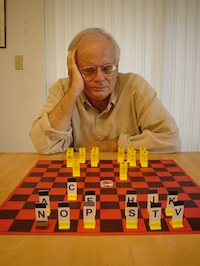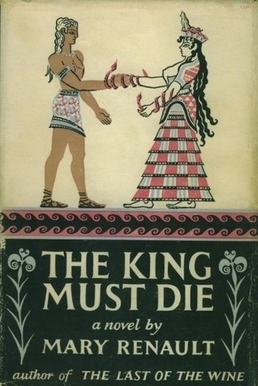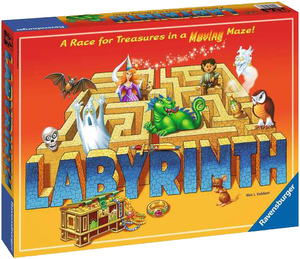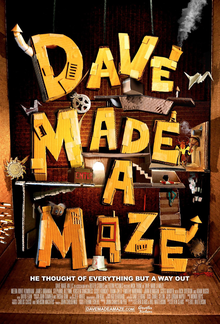
In Greek mythology, the Labyrinth was an elaborate, confusing structure designed and built by the legendary artificer Daedalus for King Minos of Crete at Knossos. Its function was to hold the Minotaur, the monster eventually killed by the hero Theseus. Daedalus had so cunningly made the Labyrinth that he could barely escape it after he built it.

A maze is a path or collection of paths, typically from an entrance to a goal. The word is used to refer both to branching tour puzzles through which the solver must find a route, and to simpler non-branching ("unicursal") patterns that lead unambiguously through a convoluted layout to a goal. The term "labyrinth" is generally synonymous with "maze", but can also connote specifically a unicursal pattern. The pathways and walls in a maze are typically fixed, but puzzles in which the walls and paths can change during the game are also categorised as mazes or tour puzzles.

In Greek mythology, the Minotaur is a mythical creature portrayed during classical antiquity with the head and tail of a bull and the body of a man or, as described by Roman poet Ovid, a being "part man and part bull". He dwelt at the center of the Labyrinth, which was an elaborate maze-like construction designed by the architect Daedalus and his son Icarus, upon command of King Minos of Crete. The Minotaur was eventually killed by the Athenian hero Theseus.

In Greek mythology, KingMinos was a king of Crete, son of Zeus and Europa. Every nine years, he made King Aegeus pick seven young boys and seven young girls to be sent to Daedalus's creation, the labyrinth, to be eaten by the Minotaur. After his death, King Minos became a judge of the dead in the underworld. Ariadne helped Theseus get into the maze, kill the Minotaur and get out and rescue the tributes. Theseus father saw black sails on there ship and thought that his son Theseus had died. He killed himself and Theseus became the new king of Athens.

Theseus was a divine hero and the founder of Athens from Greek mythology. The myths surrounding Theseus, his journeys, exploits, and friends, have provided material for storytelling throughout the ages.

In Greek mythology, Ariadne was a Cretan princess, the daughter of King Minos of Crete. There are different variations of Ariadne's myth, but she is known for helping Theseus escape from the Minotaur and being abandoned by him on the island of Naxos. There, Dionysus saw Ariadne sleeping, fell in love with her, and later married her. Many versions of the myth recount Dionysus throwing Ariadne's jeweled crown into the sky to create a constellation, the Corona Borealis.

The StoryTeller is a live-action/puppet television series that originally aired in 1987 and which was created and produced by Jim Henson.

Robert Abbott was an American game inventor, sometimes referred to by fans as "The Official Grand Old Man of Card Games". Though early in his life he worked as a computer programmer with the IBM 360 assembly language, he began designing games in the 1950s.

The King Must Die is a 1958 bildungsroman and historical novel by Mary Renault that traces the early life and adventures of Theseus, a hero in Greek mythology. It is set in locations throughout Ancient Greece: Troizen, Corinth, Eleusis, Athens, Knossos in Crete, and Naxos. Renault wrote a sequel, The Bull from the Sea, in 1962.
The Horns of Nimon is the fifth and final broadcast serial of the 17th season of the British science fiction television series Doctor Who, which was first broadcast in four weekly parts on BBC1 from 22 December 1979 to 12 January 1980. It is the last broadcast of David Brierley's voice as K9.

Labyrinth is a board game for two to four players, published by Ravensburger in 1986.

Into the Labyrinth is the sixth studio album by Australian band Dead Can Dance, released on 13 September 1993, by 4AD. It marked a strong shift from their previous albums, putting ethnic music influences at the forefront, as would be the case in the later albums. It was their first album completed on their own without the aid of guest musicians, and their first album to have a major-label release in the US, thanks to a distribution deal that 4AD had with Warner Bros. Records. It featured the single "The Ubiquitous Mr Lovegrove". Into the Labyrinth was a major success, selling more than 500,000 copies worldwide.
Logic mazes, sometimes called mazes with rules or multi-state mazes, are logic puzzles with all the aspects of a tour puzzle that fall outside of the scope of a typical maze. These mazes have special rules, sometimes including multiple states of the maze or navigator. A ruleset can be basic or complex. Popular logic mazes include tilt mazes and other novel designs which usually increase the complexity of the maze, sometimes to the point that the maze has to be designed by a program to eliminate multiple paths.

Advanced Dungeons & Dragons: Treasure of Tarmin is a video game for the Intellivision video game console and the Mattel Aquarius computer system. This game was a licensed Dungeons & Dragons adaptation. It is a successor game to Advanced Dungeons & Dragons: Cloudy Mountain (1982).
Cretan Chronicles is a trilogy of single-player role-playing fantasy gamebooks written by John Butterfield, David Honigmann and Philip Parker, and illustrated by Dan Woods. The Cretan Chronicles were published by Puffin between 1985 and 1986 under the Adventure Gamebooks banner, which also covered the more popular Fighting Fantasy and the related Sorcery! series, as well as the one-off Shakespearean-era role-playing game Maelstrom.

The Minotaur is an opera in two acts, with 13 scenes by English composer Harrison Birtwistle to a libretto by poet David Harsent, commissioned by the Royal Opera House in London. The work, a retelling of the Greek myth of the Minotaur, premiered at the Royal Opera House on 15 April 2008 under the stage direction of Stephen Langridge. The score is modernistic, and the scenes fall into three types: bullfights; scenes between Ariadne and Theseus; and dream sequences for the Minotaur, in which the creature has the gift of speech. The opera lasts about 140 minutes. A detailed analysis of the opera was published by Rhian Samuel.
In Greek mythology, the people of Athens were at one point compelled by King Minos of Crete to choose 14 young noble citizens to be offered as sacrificial victims to the half-human, half-taurine monster Minotaur to be killed in retribution for the death of Minos' son Androgeos.
Minotaur is the name of different fictional characters appearing in American comic books published by Marvel Comics.

Dave Made a Maze is a 2017 American fantasy adventure comedy horror film directed by Bill Watterson, and starring Nick Thune, Meera Rohit Kumbhani, Kirsten Vangsness, Stephanie Allynne, James Urbaniak and John Hennigan. The film centers on the titular Dave who builds a cardboard fort that somehow supernaturally houses an entire labyrinth full of deadly traps and creatures. It premiered at the Slamdance Film Festival on January 21, 2017, where it won an Audience Award for Best Narrative. It was released on August 18, 2017, by Gravitas Ventures.

Theseus and the Minotaur is a 1982 video game published by TSR for the Apple II.















